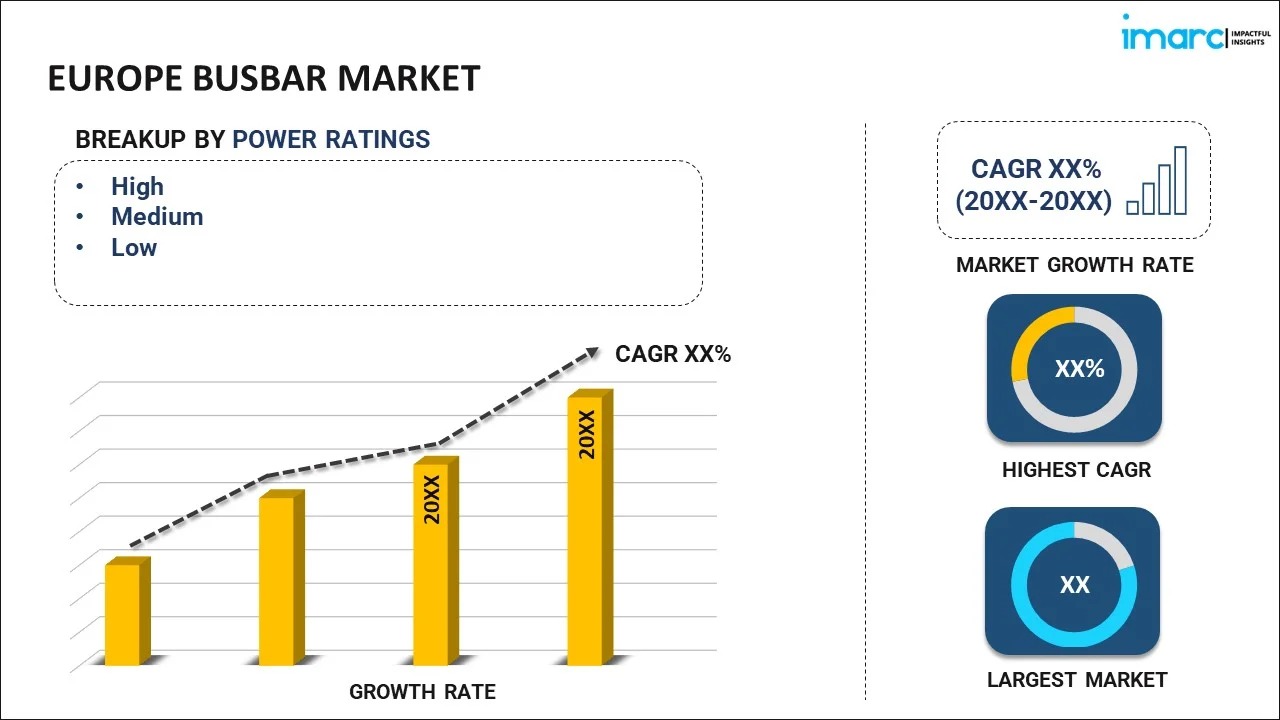
Europe Busbar Market Report by Power Rating (High, Medium, Low), Conductor (Copper, Aluminium), End User (Industrial, Commercial, Residential, Utilities), Industry (Chemicals and Petroleum, Metals and Mining, Manufacturing, and Others), and Country 2025-2033
Market Overview:
The Europe busbar market size reached USD 4,396.3 Million in 2024. Looking forward, IMARC Group expects the market to reach USD 7,387.5 Million by 2033, exhibiting a growth rate (CAGR) of 5.64% during 2025-2033.
|
Report Attribute
|
Key Statistics
|
|---|---|
|
Base Year
|
2024
|
|
Forecast Years
|
2025-2033
|
|
Historical Years
|
2019-2024
|
|
Market Size in 2024
|
USD 4,396.3 Million |
|
Market Forecast in 2033
|
USD 7,387.5 Million |
| Market Growth Rate 2025-2033 | 5.64% |
Busbars are strips of conductive materials utilized for collecting and distributing electric power from feeders. They are used in electrical installations for distributing power from a supply point to several output circuits. They are also employed in various configurations ranging from vertical risers to bars used entirely within a distribution panel or an industrial process across Europe.
Busbars are gaining immense traction in the different parts of Europe, which can be attributed to their cost-efficiency and fast installation services, with no downtime. They also help in reducing system costs, improving reliability, increasing capacitance and eliminating wiring errors. Moreover, they require few installation materials, employ reusable and re-locatable plug-in outlets, and make the power distribution process easier, flexible and hassle-free. On account of these advantages, the application of busbars is expanding across factories, data centers, retail facilities, hospitals, laboratories, universities, metros and railways. Other than this, the rising investments for establishing effective power supply networks and smart distribution systems are expected to impact market growth positively in the coming years.
Key Market Segmentation:
IMARC Group provides an analysis of the key trends in each sub-segment of the Europe busbar market report, along with forecasts at the regional and country level from 2025-2033. Our report has categorized the market based on power rating, conductor, end user and industry.
Breakup by Power Rating:

- High
- Medium
- Low
Breakup by Conductor:
- Copper
- Aluminium
Breakup by End User:
- Industrial
- Commercial
- Residential
- Utilities
Breakup by Industry:
- Chemicals and Petroleum
- Metals and Mining
- Manufacturing
- Others
Breakup by Country:
- Germany
- France
- United Kingdom
- Italy
- Spain
- Others
Competitive Landscape:
The competitive landscape of the industry has also been examined along with the profiles of the key players.
Report Coverage:
| Report Features | Details |
|---|---|
| Base Year of the Analysis | 2024 |
| Historical Period | 2019-2024 |
| Forecast Period | 2025-2033 |
| Units | Million USD |
| Segment Coverage | Power Rating, Conductor, End User, Industry, Country |
| Countries Covered | Germany, France, Italy, United Kingdom, Spain, Others |
| Customization Scope | 10% Free Customization |
| Post-Sale Analyst Support | 10-12 Weeks |
| Delivery Format | PDF and Excel through Email (We can also provide the editable version of the report in PPT/Word format on special request) |
Key Questions Answered in This Report
The Europe busbar market was valued at USD 4,396.3 Million in 2024.
We expect the Europe busbar market to exhibit a CAGR of 5.64% during 2025-2033.
The increasing demand for uninterrupted and reliable power supply across the residential, commercial, and industrial sectors is primarily driving the Europe busbar market.
The sudden outbreak of the COVID-19 pandemic had led to the implementation of stringent lockdown regulations across several European nations, resulting in the temporary closure of numerous end-use industries for busbars.
Based on the power rating, the Europe busbar market has been divided into high, medium, and low. Among these, low currently exhibits a clear dominance in the market.
Based on the conductor, the Europe busbar market can be categorized into copper and aluminium. Currently, copper accounts for the majority of the global market share.
Based on the end user, the Europe busbar market has been segregated into industrial, commercial, residential, and utilities. Among these, industrial currently exhibits a clear dominance in the market.
Based on the industry, the Europe busbar market can be bifurcated into chemicals and petroleum, metals and mining, manufacturing, and others. Currently, chemicals and petroleum holds the largest market share.
On a regional level, the market has been classified into Germany, France, United Kingdom, Italy, Spain, others, where Germany currently dominates the Europe busbar market.
Need more help?
- Speak to our experienced analysts for insights on the current market scenarios.
- Include additional segments and countries to customize the report as per your requirement.
- Gain an unparalleled competitive advantage in your domain by understanding how to utilize the report and positively impacting your operations and revenue.
- For further assistance, please connect with our analysts.
 Inquire Before Buying
Inquire Before Buying
 Speak to an Analyst
Speak to an Analyst
 Request Brochure
Request Brochure
 Request Customization
Request Customization




.webp)




.webp)












